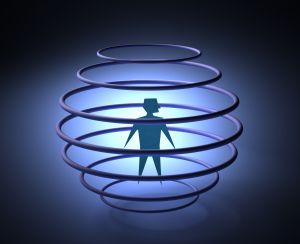Biological Mechanisms of Addiction
Biology cannot dictate what language a child will speak, what games she will play, what rites she will observe, what she will feel guilty or jealous about. But it guarantees that she will do all of those things, whether she grows up in New Jersey or New Guinea
— Eric Kandel
The pursuit of pleasure lures some individuals onto an hedonic treadmill that paradoxically makes them miserable, and from which they cannot escape. Below are some of the biological mechanisms:
1. Depressant Effects of Alcohol
Alcohol reduces the pace of brain activity by decreasing the excitatory action of the neurotransmitter glutamate and increasing the inhibitory actions of the neurotransmitter GABA. This temporary decrease in brain performance is responsible for the What Makes Intoxication Rewarding
2. Down & Up Regulation
Down-regulation - when excessive numbers of transmitter molecules are available to the receptor over a period of time, a decrease in the receptor sites can be counted. This is called down-regulation. It accounts for tolerance e.g., when heroine consistently occupies opiod binding sites. The desensitized post-synaptic neuron will not respond to average amounts of heroine, but increased amounts are required to obtain and opiod effect. This in turn induces greater levels of tolerance.
-
Up-regulation - the reverse occurs when decreased number of transmitter molecules are available at post-synaptic receptors. This leads to up-regulation with increased number of sensitized receptors. Such a condition would occur during a receptor blockade. e.g., the anti-psychotic medication thorazine bocks the dopamine receptor inducing up-regulation. As a result, additional dopamine receptors appear on the post-synaptic membrane. At this point the post-synaptic neuron is hypersensitive, and if the blockade is ended, even average amounts of dopamine can cause the movement disorder: Tardive Dyskinesia. This condition may be treated by administration of dopamine agonists or by reestablishing the dopamine blockade.
3. Acute Alcohol Withdrawal Syndrome
Following the abrupt cessation of heavy drinking, compensatory mechanisms attempting to overcome alcohol's depressing effect on glutamate systems have the effect of increasing glutamate function
This, together with a corresponding down regulation of inhibitory GABA function, causes brain hyper-excitability characteristic of acute withdrawal syndrome. 1
Some brain damage occurs during acute alcohol withdrawal, and the severity of the symptoms increases after repeated withdrawal episodes. 2
Withdrawal triggers the body's stress response, leading to elevated levels of the stress hormone cortisol, which can kill neurons in the hippocampus, promoting disorders of mood and intellect. 3
-
The consequences of sobriety following chronic alcohol abuse on brain structure and function is complex, but some recent observations have been surprisingly encouraging. For more, please visit: Alcohol and Brain.
3. Neuroadaptation and Voluntary Behavior
Repeated exposure to a drug produces long term changes in nervous system.
-
Tolerance - To enable normal functioning in the presence of a drug, compensatory reactions, that oppose the acute effects of the drug, result in a diminished effect of a given dose of the drug over repeated exposures.
-
Sensitization - refers to an increased response to a drug effect following repeated uses. One example is the decrease in the threshold for brain seizures with repeated exposure to cocaine. [For more on: behavior driven by compulsion vs. behavior driven by reward, please visit Sham Reward and Stimulants.]
The transition from voluntary use to addiction occurs through a combination of processes, including neuroadaptations that result from repeated exposure to the addictive experience. Sensitization is behind the compulsion to engage in the addictive behavior.4
An individual makes a voluntary decision to experiment with the addictive experience. But continued exposure to this experience over time produces neuroadaptations that show up as a compulsive attraction to the addictive experience. If the term disease is appropriate for addictive disorders, it refers to the changes in brain structure and function that give rise to dependence and self-destructive behavior patterns we see in addictive disorders.
4. Withdrawal: Acute and Chronic Effects
Well understood biological reactions underlie both the short-term [acute] response to drug ingestion, and the establishment of the long-term [chronic] craving that characterizes addiction. Of concern is the recent discovery that some neuroadaptations are irreversible! Once the body has been altered by repeated drug administrations, the absence of the drug produces a persistent discomfort that seeks removal by a return to the familiar comfort that would result from a return to the addictive behavior.
5. Addiction and Volition (Will)
Most people who have fallen into an addictive trap never escape. However, good long-term outcome is possible, and high-functioning individuals who appreciate the true nature of their challenge and have access to effective relapse prevention strategies can enhance the power of their will so they are able to act in accord with their interests and principles.
References:
1. Gordis, E. Alcohol, the Brain, and Behavior. Alcohol Research and Health. 2000, 24, 12-15
2. Becker, H. Kindling in Alcohol Withdrawal. Alcohol Research and Health. 1998, 22, 25-33
3. Adinoff, B, etal. Disturbance of the Stress Response. Alcohol Research and Health. 1998, 22, 67-71.
4. Robinson, R & Berridge, K. The Neural Basis of Drug Craving. Brain
Research Reviews, 1993, 17, 247-291
